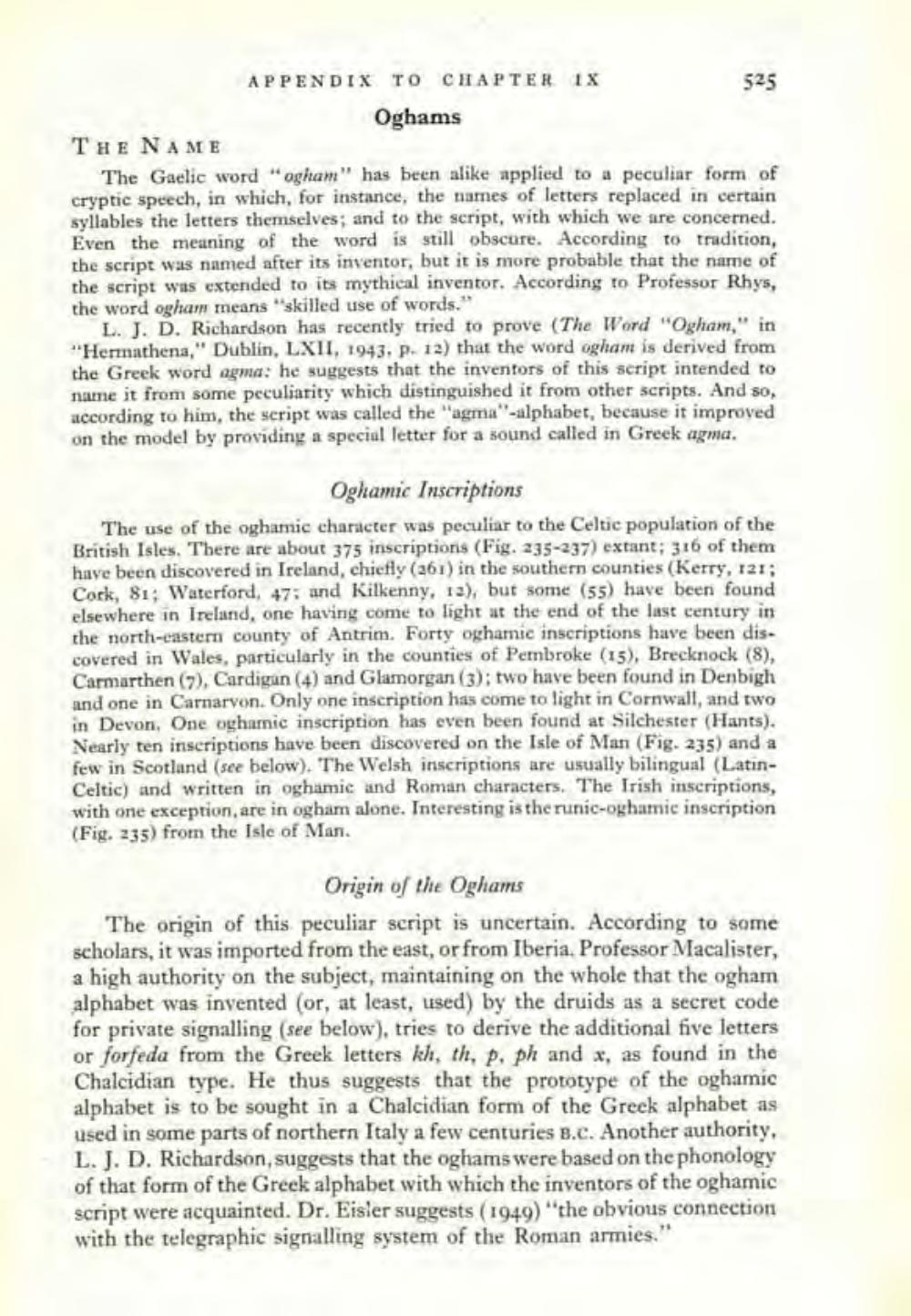________________
APPENDIX TO CHAPTERIX
525 Oghams THE NAME
The Gaelic word "ogham" has been alike applied to a peculiar form of cryptic speech, in which, for instance, the names of letters replaced in certain syllables the letters themselves; and to the script, with which we are concerned. Even the meaning of the word is still obscure. According to tradition, the script was named after its inventor, but it is more probable that the name of the script was extended to its mythical inventor. According to Professor Rhys, the word ogham means ''skilled use of words."
L. J. D. Richardson has recently tried to prove (The Word "Ogham," in "Herathena, Dublin, LXII, 1943, p. 12) that the word ogham is derived from the Greek word agma: he suggests that the inventors of this script intended to name it from some peculiarity which distinguished it from other scripts. And so, according to him, the script was called the "agma"-alphabet, because it improved on the model by providing a special letter for a sound called in Greek agma.
Oghamic Inscriptions The use of the oghamic character was peculiar to the Celtic population of the British Isles. There are about 375 inscriptions (Fig. 235-237) extant; 316 of them have been discovered in Ireland, chiefly (261) in the southern counties (Kerry, 121; Cork, 81; Waterford, 47: and Kilkenny, 12), but some (55) have been found elsewhere in Ireland, one having come to light at the end of the last century in the north-eastern county of Antrim. Forty oghamic inscriptions have been discovered in Wales, particularly in the counties of Pembroke (15), Brecknock (8), Carmarthen (7), Cardigun (4) and Glamorgan (3): two have been found in Denbigh and one in Carnarvon. Only one inscription has come to light in Cornwall, and two in Devon, One oghamic inscription has even been found at Silchester (Hants). Nearly ten inscriptions have been discovered on the Isle of Man (Fig. 235) and a few in Scotland (see below). The Welsh inscriptions are usually bilingual (LatinCeltic) and written in oghamic and Roman characters. The Irish inscriptions, with one exception, are in ogham alone. Interesting is the runic-oghamic inscription (Fig. 235) from the Isle of Man
Origin of the Oghams The origin of this peculiar script is uncertain. According to some scholars, it was imported from the east, or from Iberia. Professor Macalister, a high authority on the subject, maintaining on the whole that the ogham alphabet was invented (or, at least, used) by the druids as a secret code for private signalling (see below), tries to derive the additional five letters or forfeda from the Greek letters kh, th, p. ph and x, as found in the Chalcidian type. He thus suggests that the prototype of the oghamic alphabet is to be sought in a Chalcidian form of the Greek alphabet as used in some parts of northern Italy a few centuries B.C. Another authority,
D. Richardson, suggests that the oghams were based on the phonology of that form of the Greek alphabet with which the inventors of the oghamic script were acquainted. Dr. Eisler suggests (1949) "the obvious connection with the telegraphic signalling system of the Roman armies."




